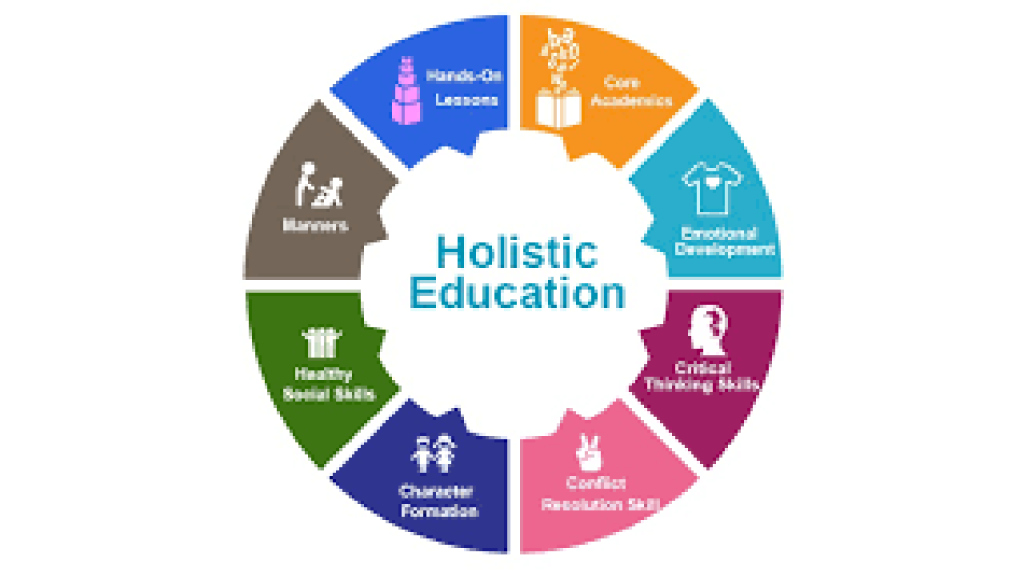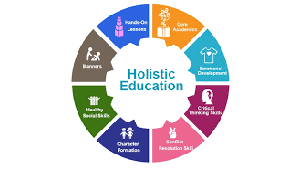Holistic education is an approach that recognizes the interconnectedness of the mind, body, and spirit in the learning process. It goes beyond traditional academic learning and focuses on nurturing emotional intelligence, creativity, critical thinking, and social skills. By integrating these aspects into the curriculum, holistic education aims to prepare students for the complexities of the real world.
Holistic education emphasizes the importance of addressing the whole person, rather than just focusing on academic achievements. It recognizes that students are unique individuals with diverse abilities and talents, and it encourages them to explore their passions, build self-confidence, and develop a sense of purpose. This approach creates a nurturing environment that fosters a love for learning and equips students with the skills and attitudes necessary to thrive in an ever-changing society.

In a holistic education setting, students are encouraged to think critically, ask questions, and actively participate in their own learning. They are given opportunities to engage in hands-on activities, collaborate with peers, and apply their knowledge to real-world situations. This not only enhances their understanding of academic subjects but also helps them develop essential life skills such as problem-solving, communication, and teamwork.
Benefits of holistic education
Holistic education offers numerous benefits for students. Firstly, it promotes a well-rounded education that addresses the needs of the whole child. By nurturing the emotional, physical, and spiritual aspects of students, holistic education helps them develop a strong sense of self-awareness, empathy, and resilience. This, in turn, leads to improved mental well-being and overall happiness.
Secondly, holistic education encourages students to explore their passions and interests. By providing a wide range of learning experiences, such as art, music, sports, and community service, students have the opportunity to discover their unique talents and strengths. This not only boosts their self-confidence but also motivates them to pursue their goals and aspirations.
Holistic education enhances critical thinking and problem-solving skills. By encouraging students to think independently, analyze information from multiple perspectives, and find creative solutions to complex problems, holistic education prepares them for the challenges of the real world. These skills are highly valued in today’s society, where innovation and adaptability are key to success.
Another benefit of holistic education is its focus on character development. Through activities such as mindfulness, character education, and community service, students learn important values such as compassion, integrity, and respect for others. These values are essential for building positive relationships, fostering a sense of belonging, and creating a harmonious community.
Holistic education provides a comprehensive and balanced approach to learning that prepares students for life beyond the classroom. It empowers them to become lifelong learners, responsible citizens, and compassionate individuals who can make a positive impact on the world.
Holistic education vs traditional education
Holistic education differs from traditional education in several key ways. While traditional education primarily focuses on academic subjects and standardized testing, holistic education takes a more comprehensive and personalized approach to learning.
In traditional education, the emphasis is often placed on memorization and regurgitation of facts. Students are evaluated based on their ability to recall information rather than their understanding and application of knowledge. This can lead to a passive learning experience, where students are not actively engaged or encouraged to think critically.
On the other hand, holistic education promotes active learning and critical thinking. Students are encouraged to ask questions, explore different perspectives, and apply their knowledge to real-world situations. This not only enhances their understanding of academic subjects but also helps them develop important life skills such as problem-solving, communication, and collaboration.
Traditional education often follows a rigid curriculum that leaves little room for creativity and individuality. Students are expected to conform to a set of predetermined standards and expectations. This can stifle their natural curiosity and limit their potential for growth and self-expression.
Holistic education, on the other hand, recognizes that students are unique individuals with diverse abilities and talents. It encourages them to explore their passions, interests, and learning styles. This personalized approach to education fosters a love for learning and allows students to develop their own unique strengths and talents.
In traditional education, the focus is primarily on academic achievement and preparing students for future careers. While this is important, holistic education takes a broader view of success. It recognizes that academic excellence alone is not enough to thrive in the real world. Students need to develop emotional intelligence, social skills, and a sense of purpose to navigate the complexities of life.
Holistic education aims to prepare students for life beyond the classroom by equipping them with the skills and attitudes necessary for personal and professional success. It recognizes the interconnectedness of the mind, body, and spirit and seeks to nurture all aspects of a student’s development.
Impact of holistic education on students’ overall development
Holistic education has a profound impact on students’ overall development. By addressing the needs of the whole child – mind, body, and spirit – holistic education nurtures students’ intellectual, emotional, social, and physical well-being.
One of the key impacts of holistic education is the promotion of self-awareness and self-confidence. By encouraging students to explore their passions, interests, and strengths, holistic education helps them develop a strong sense of identity and purpose. This, in turn, boosts their self-esteem and self-confidence, which are essential for personal and academic success.
Holistic education also enhances students’ emotional intelligence. By providing opportunities for reflection, mindfulness, and emotional expression, holistic education helps students develop a deep understanding of their own emotions and the emotions of others. This promotes empathy, compassion, and effective communication skills, which are crucial for building positive relationships and resolving conflicts.
Holistic education fosters creativity and critical thinking skills. By encouraging students to think independently, analyze information from multiple perspectives, and find innovative solutions to problems, holistic education prepares them for the challenges of the real world. These skills are highly valued in today’s society, where the ability to think critically and creatively is essential for success.
Holistic education promotes physical well-being through the integration of physical activities, sports, and healthy lifestyle habits. By encouraging students to engage in regular physical exercise, eat nutritious food, and practice self-care, holistic education helps them develop a strong foundation for a healthy and active lifestyle.
Holistic education nurtures social skills and a sense of community. By providing opportunities for collaboration, teamwork, and community service, holistic education teaches students the importance of working together and making a positive impact on the world. These experiences not only foster a sense of belonging but also instill a sense of responsibility and civic engagement.
Holistic education has a transformative impact on students’ overall development. It prepares them for life beyond the classroom by equipping them with the skills, attitudes, and values necessary to thrive in a complex and interconnected world.
Holistic education in practice: Examples and case studies
Holistic education is not just a theoretical concept – it is a practical approach to teaching and learning that can be implemented in various educational settings. Let’s explore some examples and case studies that highlight the effectiveness of holistic education.
Case Study 1
Green School, Bali Green School in Bali is a prime example of holistic education in practice. This school follows a holistic curriculum that integrates academic subjects with environmental education, sustainability, and community service. Students at Green School have the opportunity to engage in hands-on learning experiences such as organic farming, renewable energy projects, and building sustainable structures. This approach not only enhances their understanding of academic subjects but also instills a deep appreciation for nature and a sense of responsibility towards the environment.
Case Study 2
Montessori Education, Montessori education is another example of holistic education. Developed by Maria Montessori, this approach emphasizes hands-on learning, individualized instruction, and the importance of the whole child. In a Montessori classroom, students have the freedom to choose their own activities and work at their own pace. They are encouraged to explore their interests, develop their own learning plans, and collaborate with peers. This student-centered approach fosters independence, self-confidence, and a love for learning.
Case Study 3
Project-based Learning Project-based learning is a teaching method that encourages students to work on real-world projects that are relevant to their interests and passions. This approach integrates academic subjects with problem-solving, critical thinking, and collaboration.
Students have the opportunity to apply their knowledge and skills to meaningful projects, such as designing a sustainable community, creating a business plan, or developing a social initiative. This hands-on approach not only enhances their understanding of academic subjects but also prepares them for the challenges of the real world.
These case studies demonstrate the effectiveness of holistic education in fostering a love for learning, developing essential life skills, and preparing students for life beyond the classroom. By integrating academic subjects with real-world experiences, holistic education creates a meaningful and engaging learning environment that nurtures the whole child.
Implementing holistic education in schools and classrooms
Implementing holistic education in schools and classrooms requires a shift in mindset, curriculum, and instructional practices. Here are some strategies and approaches that can help educators embrace holistic education and create a nurturing learning environment.
Personalized Learning
Recognize that students have unique abilities, interests, and learning styles. Provide opportunities for individualized instruction, choice, and autonomy in the learning process. Tailor instruction to meet the diverse needs of students and create a personalized learning plan that allows them to explore their passions and interests.
Integrated Curriculum
Integrate academic subjects with real-world experiences, such as project-based learning, field trips, and guest speakers. Create interdisciplinary units of study that connect multiple subjects and encourage students to make connections between different areas of knowledge.
Active Learning
Promote active learning by providing hands-on experiences, problem-solving activities, and collaborative projects. Encourage students to think critically, ask questions, and apply their knowledge to real-world situations. Use technology, manipulatives, and other resources to engage students in the learning process.
Social and Emotional Learning
Teach social and emotional skills explicitly through activities such as mindfulness, character education, and conflict resolution. Create a supportive and inclusive classroom environment that promotes empathy, respect, and positive relationships. Provide opportunities for reflection, self-expression, and emotional regulation.
Community Engagement
Foster a sense of community and civic engagement by involving students in community service projects, partnerships with local organizations, and initiatives that address real-world issues. Encourage students to make a positive impact on their community and develop a sense of responsibility towards others.
Professional Development
Provide ongoing professional development opportunities for teachers to learn about holistic education, explore new instructional strategies, and collaborate with colleagues. Support teachers in implementing holistic education in their classrooms through coaching, mentoring, and resources.
By implementing these strategies, educators can create a holistic learning environment that nurtures the whole child and prepares students for life beyond the classroom.
Challenges and misconceptions of holistic education
While holistic education offers numerous benefits and transformative potential, it also faces certain challenges and misconceptions that can hinder its implementation. Let’s explore some of these challenges and misconceptions.
Standardized Testing
One of the challenges of holistic education is the focus on standardized testing in many educational systems. Standardized tests primarily measure students’ academic knowledge and do not capture the full range of skills and abilities nurtured by holistic education. This can create tension between the holistic approach and the demands of standardized testing.
Time Constraints
Implementing holistic education requires time for reflection, hands-on activities, and personalized learning experiences. The pressure to cover a wide range of academic subjects and meet curriculum standards can limit the time available for holistic practices. Finding a balance between academic requirements and holistic education can be challenging.
Resistance to Change
Shifting from a traditional education model to a holistic approach requires a change in mindset, instructional practices, and school culture. Resistance to change from educators, administrators, and parents can pose challenges to implementing holistic education. Educating stakeholders about the benefits and principles of holistic education and providing support and resources can help overcome resistance.
Misconceptions
One common misconception about holistic education is that it neglects academic rigor and focuses solely on personal development. Holistic education emphasizes the integration of academic subjects with the development of life skills, values, and character. It recognizes that academic excellence is important but not sufficient for success in the real world.
Lack of Resources
Implementing holistic education may require additional resources, such as materials for hands-on activities, technology tools, and professional development opportunities for teachers. Limited resources can present challenges in fully implementing holistic education, especially in underfunded schools or resource-constrained environments.
Addressing these challenges and misconceptions requires a collective effort from educators, administrators, policymakers, and parents. By advocating for holistic education, providing the necessary resources and support, and fostering a culture of continuous improvement, we can overcome these challenges and fully realize the transformative potential of holistic education.
Role of teachers and parents in holistic education
Teachers and parents play a crucial role in supporting holistic education and nurturing the whole child. Let’s explore the roles and responsibilities of teachers and parents in promoting holistic education.
Teachers have a unique opportunity to create a nurturing learning environment that embraces holistic education. They can:
Create a Safe and Supportive Classroom
Teachers can create a classroom environment that promotes emotional safety, respect, and inclusivity. By fostering a sense of belonging and acceptance, teachers create a foundation for holistic education.
Emphasize Individuality
Teachers can recognize and celebrate the unique abilities, interests, and learning styles of each student. By providing opportunities for choice, autonomy, and personalization, teachers empower students to take ownership of their learning.
Foster Critical Thinking and Problem-solving Skills
Teachers can engage students in activities that promote critical thinking, problem-solving, and creativity. By encouraging students to think independently, analyze information, and find innovative solutions, teachers foster essential life skills.
Encourage Collaboration and Communication
Teachers can create opportunities for collaboration, teamwork, and effective communication. By providing opportunities for students to work together, share ideas, and learn from each other, teachers help develop social skills and promote a sense of community.
Integrate Social and Emotional Learning
Teachers can explicitly teach social and emotional skills through activities such as mindfulness, character education, and conflict resolution. By fostering emotional intelligence, teachers support students’ overall well-being and personal development.
Parents also play a vital role in supporting holistic education. They can:
Advocate for Holistic Education
Parents can advocate for holistic education in their child’s school by participating in parent-teacher associations, attending school board meetings, and engaging in discussions with educators. By voicing their support for holistic education, parents can contribute to its implementation and success.
Encourage a Love for Learning
Parents can foster a love for learning by providing a supportive and stimulating home environment.
Conclusion
Holistic education is a comprehensive approach that recognizes the interconnectedness of the mind, body, and spirit in the learning process. By nurturing emotional intelligence, creativity, critical thinking, and social skills, holistic education prepares students for the complexities of the real world. It promotes a well-rounded education that addresses the needs of the whole child, encourages the exploration of passions and interests, enhances critical thinking and problem-solving skills, and focuses on character development.
Holistic education empowers students to become lifelong learners, responsible citizens, and compassionate individuals who can make a positive impact on the world.
Compared to traditional education, holistic education takes a more personalized and comprehensive approach to learning, promoting active engagement, critical thinking, and individuality. Overall, holistic education has a profound impact on students’ overall development, nurturing their intellectual, emotional, social, and physical well-being.




